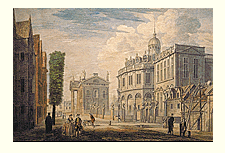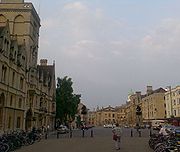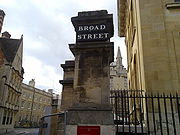
Broad Street, Oxford
Encyclopedia

Oxford
The city of Oxford is the county town of Oxfordshire, England. The city, made prominent by its medieval university, has a population of just under 165,000, with 153,900 living within the district boundary. It lies about 50 miles north-west of London. The rivers Cherwell and Thames run through...
, England
England
England is a country that is part of the United Kingdom. It shares land borders with Scotland to the north and Wales to the west; the Irish Sea is to the north west, the Celtic Sea to the south west, with the North Sea to the east and the English Channel to the south separating it from continental...
, located just north of the old city wall.
The street is known for its bookshops, including the original Blackwell's
Blackwell's
Blackwell UK Ltd is a national chain of bookshops, online retail, mail order and library supply services in the United Kingdom, which has an annual turnover of £74 million...
bookshop at number 50, located here due to the University
University of Oxford
The University of Oxford is a university located in Oxford, United Kingdom. It is the second-oldest surviving university in the world and the oldest in the English-speaking world. Although its exact date of foundation is unclear, there is evidence of teaching as far back as 1096...
. Locally, the street is traditionally known as The Broad.
Location
Located in Broad Street are Balliol CollegeBalliol College, Oxford
Balliol College , founded in 1263, is one of the constituent colleges of the University of Oxford in England but founded by a family with strong Scottish connections....
, Trinity College
Trinity College, Oxford
The College of the Holy and Undivided Trinity in the University of Oxford, of the foundation of Sir Thomas Pope , or Trinity College for short, is one of the constituent colleges of the University of Oxford in England. It stands on Broad Street, next door to Balliol College and Blackwells bookshop,...
, Exeter College
Exeter College, Oxford
Exeter College is one of the constituent colleges of the University of Oxford in England and the fourth oldest college of the University. The main entrance is on the east side of Turl Street...
(front entrance in the adjoining Turl Street
Turl Street
Turl Street is an historic street in central Oxford, England.- Location :The street is located in the city centre, linking Broad Street at the north and High Street at the south. It is colloquially known as The Turl and runs past three of Oxford's historic colleges: Exeter, Jesus and Lincoln...
). The Museum of the History of Science (the original location of the Ashmolean Museum
Ashmolean Museum
The Ashmolean Museum on Beaumont Street, Oxford, England, is the world's first university museum...
), the Clarendon Building
Clarendon Building
The Clarendon Building is a landmark Grade I listed building in Oxford, England, owned by the University of Oxford. It was built between 1711 and 1715 to house the Oxford University Press. It stands in the centre of the city in Broad Street, near the Bodleian Library and the Sheldonian Theatre...
, the Sheldonian Theatre
Sheldonian Theatre
The Sheldonian Theatre, located in Oxford, England, was built from 1664 to 1668 after a design by Christopher Wren for the University of Oxford. The building is named after Gilbert Sheldon, chancellor of the university at the time and the project's main financial backer...
and the new Bodleian Library
Bodleian Library
The Bodleian Library , the main research library of the University of Oxford, is one of the oldest libraries in Europe, and in Britain is second in size only to the British Library...
building (the main University library, entrance in Parks Road
Parks Road
Parks Road is a road in Oxford, England, with several Oxford University colleges along its route. It runs north-south from the Banbury Road and Norham Gardens at the northern end, where it continues into Bradmore Road, to the junction with Broad Street, Holywell Street and Catte Street to the...
) are important historical Oxford University buildings at the eastern end of the street. The question is often asked "Where is the University?". These buildings form the nearest equivalent to the centre of the University, since most academic buildings in the centre of Oxford are owned by individual (and autonomous) colleges rather than the University itself.

George Street, Oxford
George Street is a street in central Oxford, England. It is a shopping street running east-west. Its eastern end meets Broad Street at a crossroads with Cornmarket Street to the south and Magdalen Street to the north...
, with Magdalen Street
Magdalen Street
Magdalen Street is a short shopping street in central Oxford, England, just north of the original north gate in the city walls.At the southern end, Magdalen Street meets Cornmarket Street continuing to the south, Broad Street to the east and George Street to the west. At the northern end it...
to the north and Cornmarket Street
Cornmarket Street
Cornmarket Street is a major shopping street and pedestrian precinct in Oxford, England that runs north-south between Carfax Tower and Magdalen Street.Retailers in Cornmarket include:* Austin Reed...
to the south. To the east, the street continues as Holywell Street
Holywell Street
Holywell Street is a street in central Oxford, England. It runs east-west with Broad Street to the west and Longwall Street to the east. About half way along, Mansfield Road adjoins to the north.New College dominates the south side of the street...
, with Parks Road
Parks Road
Parks Road is a road in Oxford, England, with several Oxford University colleges along its route. It runs north-south from the Banbury Road and Norham Gardens at the northern end, where it continues into Bradmore Road, to the junction with Broad Street, Holywell Street and Catte Street to the...
to the north and Catte Street
Catte Street
Catte Street is a historic street in central Oxford, England.- Location :Catte Street runs north-south, continuing as Parks Road to the north...
to the south. The King's Arms
King's Arms
The King's Arms is one of the main student public houses in Oxford, England. It is located in a prominent position on the corner of Parks Road and Holywell Street, opposite the New Bodleian Library building. Also nearby are Broad Street and the Clarendon Building, part of Oxford University...
, a popular public house frequented by Oxford University students, is on the north-east corner of the junction and the Indian Institute
Indian Institute
The Indian Institute in central Oxford, England is located at the north end of Catte Street on the corner with Holywell Street and facing down Broad Street from the east...
(now The James Martin 21st Century School), designed by Basil Champneys
Basil Champneys
Basil Champneys was an architect and author whose more notable buildings include Newnham College, Cambridge, Manchester's John Rylands Library, Mansfield College, Oxford and Oriel College, Oxford's Rhodes Building.- Life :...
, is on the south-east corner.
History
The first city wall was built south of the street in 911.The street was the site where the Protestant Oxford Martyrs
Oxford Martyrs
The Oxford Martyrs were tried for heresy in 1555 and subsequently burnt at the stake in Oxford, England, for their religious beliefs and teachings....
, Hugh Latimer
Hugh Latimer
Hugh Latimer was a Fellow of Clare College, Cambridge, Bishop of Worcester before the Reformation, and later Church of England chaplain to King Edward VI. In 1555, under Queen Mary, he was burnt at the stake, becoming one of the three Oxford Martyrs of Anglicanism.-Life:Latimer was born into a...
and Nicholas Ridley
Nicholas Ridley (martyr)
Nicholas Ridley was an English Bishop of London. Ridley was burned at the stake, as one of the Oxford Martyrs, during the Marian Persecutions, for his teachings and his support of Lady Jane Grey...
(16 October 1555), and later Thomas Cranmer
Thomas Cranmer
Thomas Cranmer was a leader of the English Reformation and Archbishop of Canterbury during the reigns of Henry VIII, Edward VI and, for a short time, Mary I. He helped build a favourable case for Henry's divorce from Catherine of Aragon which resulted in the separation of the English Church from...
(21 March 1556), were burnt at the stake just outside the then northern city walls. A cobbled cross in the road opposite Balliol College marks the location. Not far away in St Giles', the events are commemorated with a Victorian stone monument, the Martyrs' Memorial
Martyrs' Memorial
The Martyrs' Memorial is a stone monument positioned at the intersection of St Giles', Magdalen Street and Beaumont Street in Oxford, England just outside Balliol College...
.

Sheldonian Theatre
The Sheldonian Theatre, located in Oxford, England, was built from 1664 to 1668 after a design by Christopher Wren for the University of Oxford. The building is named after Gilbert Sheldon, chancellor of the university at the time and the project's main financial backer...
, set back from Broad Street behind a stone wall and railings with impressive stones heads (traditionally Roman emperor
Roman Emperor
The Roman emperor was the ruler of the Roman State during the imperial period . The Romans had no single term for the office although at any given time, a given title was associated with the emperor...
s), was built 1664–1668 from a design by Sir Christopher Wren
Christopher Wren
Sir Christopher Wren FRS is one of the most highly acclaimed English architects in history.He used to be accorded responsibility for rebuilding 51 churches in the City of London after the Great Fire in 1666, including his masterpiece, St. Paul's Cathedral, on Ludgate Hill, completed in 1710...
for the University of Oxford
University of Oxford
The University of Oxford is a university located in Oxford, United Kingdom. It is the second-oldest surviving university in the world and the oldest in the English-speaking world. Although its exact date of foundation is unclear, there is evidence of teaching as far back as 1096...
. The Old Ashmolean Building was built in 1683 to house Elias Ashmole
Elias Ashmole
Elias Ashmole was a celebrated English antiquary, politician, officer of arms, astrologer and student of alchemy. Ashmole supported the royalist side during the English Civil War, and at the restoration of Charles II he was rewarded with several lucrative offices.Ashmole was an antiquary with a...
's collection. It was the world's first museum to open to the public. The Clarendon Building
Clarendon Building
The Clarendon Building is a landmark Grade I listed building in Oxford, England, owned by the University of Oxford. It was built between 1711 and 1715 to house the Oxford University Press. It stands in the centre of the city in Broad Street, near the Bodleian Library and the Sheldonian Theatre...
was built 1711–1715 to house the Oxford University Press
Oxford University Press
Oxford University Press is the largest university press in the world. It is a department of the University of Oxford and is governed by a group of 15 academics appointed by the Vice-Chancellor known as the Delegates of the Press. They are headed by the Secretary to the Delegates, who serves as...
's printing operations. It was designed by Nicholas Hawksmoor
Nicholas Hawksmoor
Nicholas Hawksmoor was a British architect born in Nottinghamshire, probably in East Drayton.-Life:Hawksmoor was born in Nottinghamshire in 1661, into a yeoman farming family, almost certainly in East Drayton, Nottinghamshire. On his death he was to leave property at nearby Ragnall, Dunham and a...
, considered Christopher Wren's best pupil.
The academic and physician Henry Acland lived in the street at number 40 on the site of the new Bodleian building.
Shops
BoswellsBoswells of Oxford
Boswells of Oxford is the largest independent department store in Oxford, England. It has been trading since 1738, initially located at 50 Cornmarket Street...
, now the largest independent department store
Department store
A department store is a retail establishment which satisfies a wide range of the consumer's personal and residential durable goods product needs; and at the same time offering the consumer a choice of multiple merchandise lines, at variable price points, in all product categories...
in Oxford, was established in 1738, and has been trading in the same spot on the south side of Broad Street opposite Balliol College ever since. Thornton's Bookshop
Thornton's Bookshop
Thornton's Bookshop is the oldest university bookshop in Oxford, England. It was founded in 1835 by Joseph Thornton in Magdalen Street....
, also on the south side of the street at No. 11, was founded by Joseph Thornton
Joseph Thornton
Joseph Thornton is a controls engineer Thornton's controls i 2009 in London, England, the oldest university bookshop in the city....
(1808–1891) in 1835, but closed its shop at the end of 2002.
The Victorian
Victorian era
The Victorian era of British history was the period of Queen Victoria's reign from 20 June 1837 until her death on 22 January 1901. It was a long period of peace, prosperity, refined sensibilities and national self-confidence...
photographer Henry Taunt
Henry Taunt
Henry William Taunt was a professional photographer based in Oxford, England. His studio was in Broad Street, Oxford.Henry Taunt was born in Penson's Gardens in St Ebbe's, Oxford...
had a shop and studio at 9–10 Broad Street, moving here from Cornmarket Street
Cornmarket Street
Cornmarket Street is a major shopping street and pedestrian precinct in Oxford, England that runs north-south between Carfax Tower and Magdalen Street.Retailers in Cornmarket include:* Austin Reed...
in 1874. He also established a picture-framing
Picture frame
A picture frame is a decorative edging for a picture, such as a painting or photograph, intended to enhance it, make it easier to display, or protect it.-Construction:...
business in Boxall's Yard, behind the premises. The lease expired in 1894 and he was forced to file for bankruptcy.
Blackwell's
Blackwell's
Blackwell UK Ltd is a national chain of bookshops, online retail, mail order and library supply services in the United Kingdom, which has an annual turnover of £74 million...
bookshop, on the north side of the street, was founded by Benjamin Henry Blackwell, the son of the first city librarian, in 1879. The shop was initially only twelve feet square, but quickly grew to include space upstairs, in the cellar, and neighbouring shops. It is now Oxford's most famous and leading bookshop, with other specialist branches elsewhere in Broad Street and Oxford.
The first Oxfam
Oxfam
Oxfam is an international confederation of 15 organizations working in 98 countries worldwide to find lasting solutions to poverty and related injustice around the world. In all Oxfam’s actions, the ultimate goal is to enable people to exercise their rights and manage their own lives...
charity shop
Charity shop
A charity shop, thrift shop, thrift store, hospice shop , resale shop or op shop is a retail establishment run by a charitable organization to raise money.Charity shops are a type of social enterprise...
together with its office were established by Cecil Jackson-Cole (1901–1979) at 17 Broad Street in 1947. There is still an Oxfam shop here and a blue plaque
Blue plaque
A blue plaque is a permanent sign installed in a public place to commemorate a link between that location and a famous person or event, serving as a historical marker....
has been placed on the outside wall of the building.

